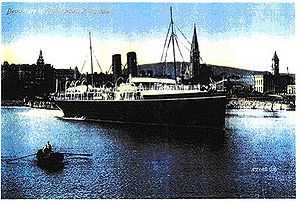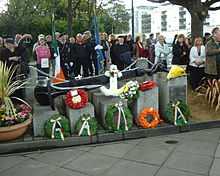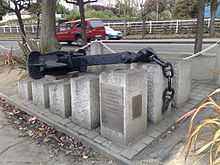RMS Leinster
 Postcard image of the RMS Leinster | |
| Career | |
|---|---|
| Name: | RMS Leinster |
| Owner: | City of Dublin Steam Packet Company |
| Port of registry: | Dublin, Ireland |
| Route: | Kingstown (now Dun Laoghaire)-Holyhead |
| Ordered: | 1895 |
| Builder: | Laird Brothers of Birkenhead |
| Cost: | £95,000 |
| Yard number: | 612 |
| Launched: | 12 September 1896 |
| Completed: | January 1897 |
| Out of service: | 10 October 1918 |
| Fate: | Torpedoed and sunk by German submarine UB-123 on 10 October 1918 while bound for Holyhead. |
| General characteristics | |
| Class and type: | Steamship |
| Tonnage: | 2,646 |
| Length: | 378 ft |
| Beam: | 75 ft |
| Height: | 42 ft |
| Installed power: | Single eight-cylinder triple-expansion steam engine |
| Propulsion: | Twin propellers |
| Speed: | 24 knots |
| Armament: | During World War I:
|
RMS Leinster was a vessel operated by the City of Dublin Steam Packet Company, served as the Kingstown (now Dún Laoghaire)-Holyhead mailboat until she was torpedoed and sunk by German submarine UB-123 on 10 October 1918, while bound for Holyhead. She went down just outside Dublin Bay at a point 4 nautical miles (7.4 km) east of the Kish light. Over 500 people perished in the sinking – the greatest single loss of life in the Irish Sea.
The official death toll was 501. However, research by Roy Stokes, author of Death in the Irish Sea: The Sinking of RMS Leinster and fellow writer Philip Lecane, author of Torpedoed! The RMS Leinster Disaster, suggests the actual total was higher.
Design
In 1895, the City of Dublin Steam Packet Company ordered four steamers for Royal Mail service, named for four provinces of Ireland, RMS Leinster, Connaught, Munster and Ulster; these four were commonly referred to as "The Provinces".
The Leinster was a 2,640-ton packet steamship with a service speed of 24 knots (44 km/h). The vessel, which was built at Laird's in Birkenhead, England, was driven by a single eight-cylinder triple-expansion steam engine. During the First World War, the twin-propellered ship was armed with one 12 pounder and two signal guns.
Sinking
The ship's log states that she carried 77 crew and 694 passengers on her final voyage under the command of Captain William Birch. The ship had previously been attacked in the Irish Sea but the torpedoes missed their target. Those on board included more than one hundred British and Irish citizens, 22 postal sorters (working in the mail room) and almost 500 military personnel from the Royal Navy, British Army and Royal Air Force. Also aboard were nurses from Britain, Ireland, Australia, New Zealand, Canada and the United States.
Just before 10 a.m. as the Leinster was sailing east of the Kish Bank in a heavy swell, passengers saw a torpedo approach from the port side and pass in front of the bow. A second torpedo followed shortly afterwards, and it struck the ship forward on the port side in the vicinity of the mail room. Captain Birch ordered the ship to make a U-turn in an attempt to return to Kingstown as the ship began to settle slowly by the bow; however, the ship sank rapidly after a third torpedo struck the Leinster, causing a huge explosion.
Despite the heavy seas, the crew managed to launch several lifeboats and some passengers clung to life-rafts. The survivors were rescued by HMS Lively, HMS Mallard and HMS Seal. Among the civilian passengers lost in the sinking were socially prominent people such as Lady Phyllis Hamilton, daughter of the Duke of Abercorn, Robert Jocelyn Alexander, son of Irish composer Cecil Frances Alexander, Thomas Foley and his wife Charlotte Foley (née Barrett) who was the brother-in-law of the world-famous Irish tenor John McCormack, Lieut. Col. Charles Harold Blackbourne, veteran of the Boer War, Alfred White Curzon King, 15-year-old nephew to Alfred Harmsworth, 1st Viscount Northcliffe, and Maud Elizabeth Ward, personal secretary to Douglas Proby. The first member of the Women's Royal Naval Service to die on active duty, Josephine Carr, was among those killed, as were two prominent trade unionists, James McCarron and Patrick Lynch.[1] Among the less well known were 15-year-old Gerald Palmer, a boy with a physical disability, from "The Cripples Home" in Bray, Co. Wicklow, and Catherine Gould and five of her six children. A Limerick paper described them as "humble decent people". Captain Birch was also among those lost in the sinking. Wounded in the initial attack, he was drowned when his lifeboat became swamped in heavy seas and capsized while trying to transfer survivors to HMS Lively. Several of the military personnel who died are buried in Grangegorman Military Cemetery.[2]
Survivors were brought to Kingstown harbour. Among the survivors were Michael Joyce, member of parliament for Limerick, and Captain Hutchinson Ingham Cone, former commander of the USS Dale (DD-4). One of the rescue ships was the armed yacht and former fishery protection vessel HMY Helga. Stationed in Kingstown harbour at the time of the sinking, she had shelled Dublin during the 1916 Easter Rising in Dublin two years earlier. She was later bought and renamed the Muirchú by the Irish Free State government as one of its first fishery protection vessels.

The UB-123 was probably lost in a minefield in the North Sea on its way back to Germany, on or about 19 October 1918. The bodies of her commander Oberleutnant zur See Robert Ramm and his crew of two officers and thirty-three men were never recovered.[3]

Commemoration
In 2008, ninety years after its sinking, a commemorative stamp was issued by An Post, recalling particularly the Post Office's 21 staff who died in the tragedy.[4] The sinking of the vessel is further recalled in the postal museum of the General Post Office, in Dublin's O'Connell Street.
See also
- Maritime disasters
References
- ↑ C. Desmond Greaves, The Irish Transport and General Workers' Union, p.221
- ↑ http://irishhistorypodcast.ie/2011/02/28/photos-and-notes-grangegorman-military-cemetery-notes/
- ↑ Roy Stokes Death in the Irish Sea: The Sinking of RMS Leinster and Philip Lecane Torpedoed! The RMS Leinster Disaster
- ↑ "Minister Hanafin launches RMS Leinster anniversary stamp". An Post. 30 May 2008. Retrieved 5 October 2010.
Further reading
- Bourke, Edward J. Shipwrecks of the Irish Coast: 1105–1993, published by the author, Dublin 1994.
- de Courcy Ireland, John "Ireland and the Irish in Maritime History", Glendale Press, Dublin 1986.
- Higgins, John (Jack) The Sinking of the R.M.S. Leinster Recalled; article in the Postal Worker (Vol 14, No 11, November 1936), the official publication of the Post Office Workers Union, written by the only survivor from the ship's mailroom.
- Lecane, Philip Torpedoed!: The R.M.S. Leinster Disaster, Published by Periscope Publishing Ltd, Cornwall TR18 2AW, Softback, ISBN 1-904381-29-4 [www.periscopepublishing.com]. Published in Ireland, hardback, ISBN 1-904381-30-8
- Stokes, Roy Death in the Irish Sea: The Sinking of RMS Leinster, Collins Press, Cork 1998. ISBN 1-898256-52-7
- Liffiton, John L. The Last Passenger Liner Sunk in the Great War. article in the Medals Society of Ireland Journal (No. 49, September 1999).
External links
- RMS Leinster "Home Site"
- The sinking of RMS Leinster
- An American eyewitness account
- A Postal Worker's account (.pdf)
- Dun Laoghaire Business Association
- Dun Laoghaire Harbour
- Irish Ships – article by Roy Stokes
- Clare casualties of war
- Communication Workers Union
- Diving information
- video of 90th anniversary
- Irish Wrecks Online